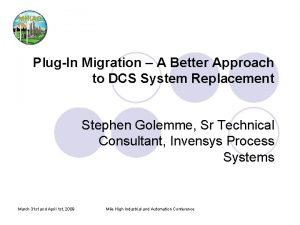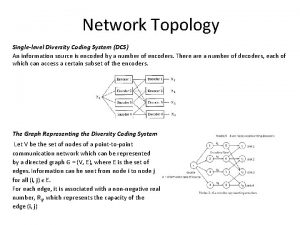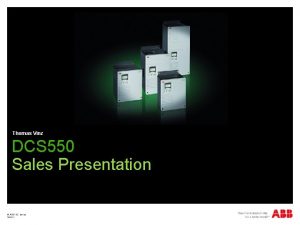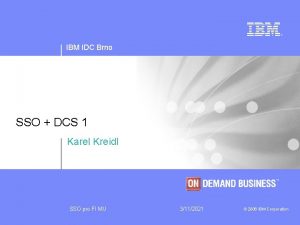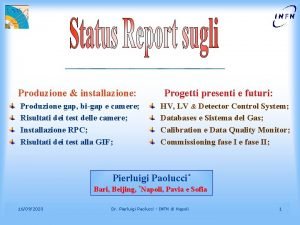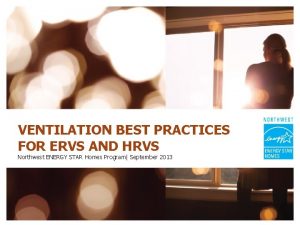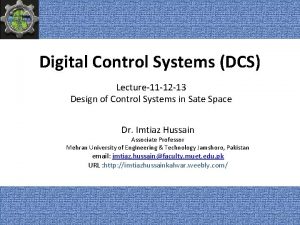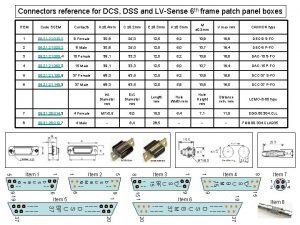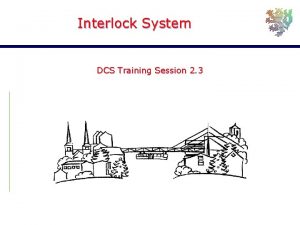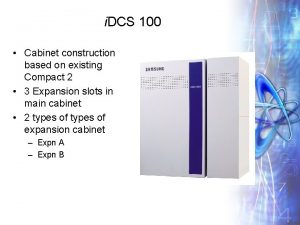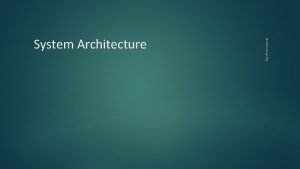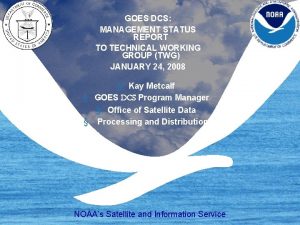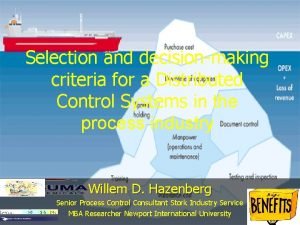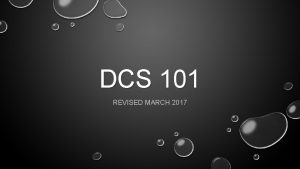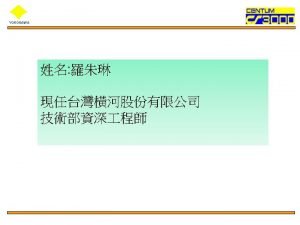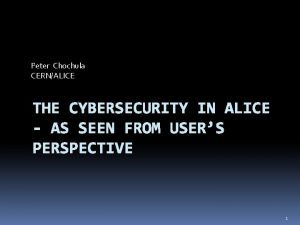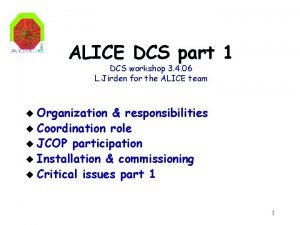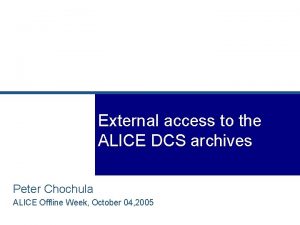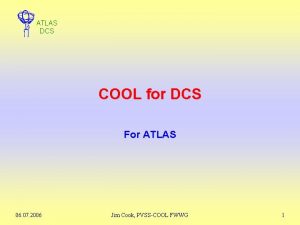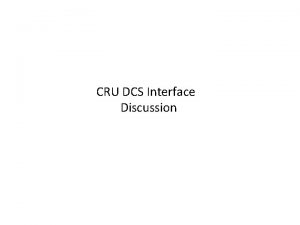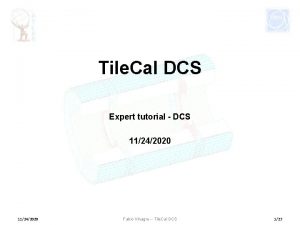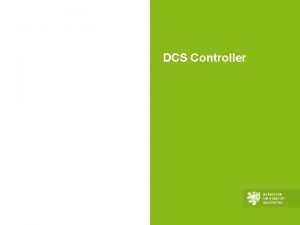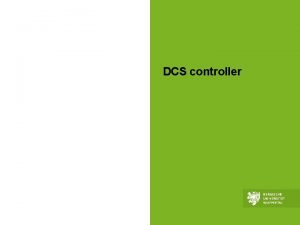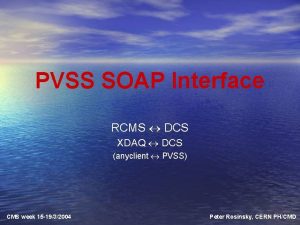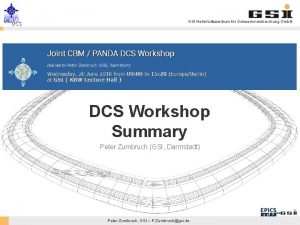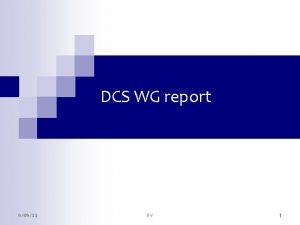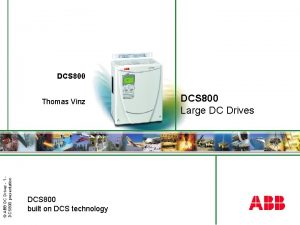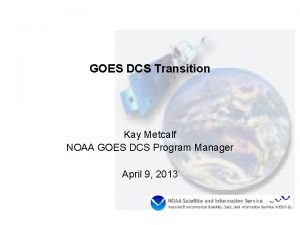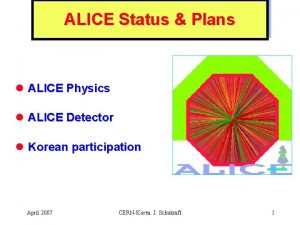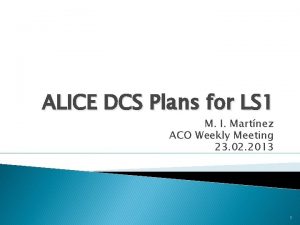ALICE DCS Technical Challenges Peter Chochula For ALICE





















































- Slides: 53

ALICE DCS – Technical Challenges Peter Chochula For ALICE DCS Peter Chochula for ALICE DCS, DCS review, Geneva April 3, 2006

Outline • ALICE Front-End and Readout Electronics • DCS Performance Studies • ALICE DCS Computing Peter Chochula for ALICE DCS, DCS review, Geneva April 3, 2006

• Alice-specific technical challenge – the Front-end and Readout electronics (FERO) Peter Chochula for ALICE DCS, DCS review, Geneva April 3, 2006

ALICE Front. End and Readout Electronics (FERO) • Several architectures for FERO access are implemented in ALICE sub-detectors – Different buses (JTAG, CAN, DDL, Ethernet, I 2 C, custom…), different operation modes – DAQ is in charge of control of architectures connected via the optical link (DDL) – DCS is in charge of controlling the rest • For some detectors both systems are involved Peter Chochula for ALICE DCS, DCS review, Geneva April 3, 2006

FERO Access Architectures Class B Class A Control: DAQ Monitoring DCS Control DAQ Monitoring DCS OR/AND DCS DDL FERO Class C Control DCS Non-DDL Class D Monitoring DCS Control DCS Monitoring and Control task are sharing the same bus and cannot operate in parallel Non-DDL FERO Peter Chochula for ALICE DCS, FERO DCS review, Geneva April 3, 2006

• The variety of FERO access mechanisms almost excludes implementation of common solutions • The Front. End Device (FED) provides a API between PVSSII and custom architectures – Standard in ALICE – API definition (Commands, Services, Operational Guidelines) available – Based on DIM Peter Chochula for ALICE DCS, DCS review, Geneva April 3, 2006

Generic Architecture of the FED Server (PVSS) DIM Client Services Commands Supervisory layer FED API FED Server Control layer Inter. Com Layer CA 1 CAi MA 1 MAi Hardware Access Field layer Hardware Peter Chochula for ALICE DCS, FED Server (DIM Server) Provides access to FED via the FED API Interc. Com layer contains detector control and monitoring code (agents) Hardware access layer contains device drivers DCS review, Geneva April 3, 2006

Example of “simple” Hardware Access Layer (SPD) (PVSS) DIM Client Inter. Com Layer CA 1 CAi MA 1 MAi Services Commands FED API FED Server Hardware Access VISA Libraries PCI-MXI Inter. Com Layer CA 1 CAi MA 1 MAi VME Crate Hardware Access. VME Master (MXI) JTAG over CO Hardware Routers Peter Chochula for ALICE DCS, DCS review, Geneva April 3, 2006

Yet Another Example of Hardware Access Layer (TPC/TRD/PHOS) (PVSS) DIM Client Inter. Com Layer CA 1 CAi MA 1 MAi Services Commands FED API FED Server Hardware Access FEE Client FED API FED Server FEE API Inter. Com Layer CA 1 CAi MA 1 MAi Hardware Access FEE Server CE Hardware DCS Board RCU/ROB Peter Chochula for ALICE DCS, DCS review, Geneva April 3, 2006

FERO and FED server configuration FED Server Configuration PVSS Configuration of the FED: alerts, monitoring parameters, services , etc. (Needed for DCS) FERO Configuration FED API Intercom F E D Hardware Access Configuration of the electronics FERO Peter Chochula for ALICE DCS, DCS review, Geneva April 3, 2006

What is stored in the FERO configuration? • The FERO Configuration contains all setting needed for the FERO operation such as – DAC settings – Thresholds – Mask matrices … • Sometimes the configuration contains code for embedded processors – This code might be compiled on-fly by dedicated software (to avoid repetition of huge data blocks) • Expected data size differs from detector to detector and ranges from few Bytes up to ~100 MB – the data might be compiled on fly, amount of data written to the FERO might be considerably bigger that the amount of data read from the DB • Some parameters written to the chips are not available for the DCS monitoring – Data cannot be easily provided to offline Peter Chochula for ALICE DCS, DCS review, Geneva April 3, 2006

Assembling a Configuration Record . ASM_MIMD CODEM add r 13 c 3 r 13 shl 1 r 11 jmp cc_carry return 1 mov bitnum work . DAT . TCS const dut = 3 reset dut write dut, NMOD, 0 x 1 C expect dut, NMOD, 0 x 1 C write NICLK, 1 TCC 10 53249 10 53250 10 53251 10 57344 127 10 57345 127 511 127 24 11 127 25 11 127 26 -1895563249 -1895825408 TRAPs . C + SCSN Master Peter Chochula for ALICE DCS, DCS review, Geneva April 3, 2006

Configuration Data Flow © PVSS FED Client Acknowledges Services ~GBs . . . ~10 -100 MB Command (Broadcast) FED Server Inter. Com Layer Command Coder FEE Client Service ACK Cmd Fee. Server incl. CE ACK Cmd Config. File Config. DB Fee. Server . . . incl. CE Load configuration data for ICL from file OR database Benjamin Schockert, Sebastian Bablok, Ralf Keidel

Status of FERO Developments • FERO access implementation is advancing well for 4 detectors: SPD, TPC, TRD and PHOS – SPD full slice is being commissioned now (ACC participation) – TPC and TRD tested the chain from intercom layer to devices, PVSS integration in progress, database tests started – PHOS aims for full chain in June (test beam) • Main worry: manpower is missing in detector teams. • ACC is providing help, but soon we will loose the key person (SK) Peter Chochula for ALICE DCS, DCS review, Geneva April 3, 2006

Obtaining the configuration data • Calibration data is a result of a complex chain of steps FERO Configuration Database Analysis Procedure Calibration Procedure (online systems) DCS Archive DAQ Data Peter Chochula for ALICE DCS, • Some detectors can execute several calibration procedures • Offline and all Online systems are involved • We are facing insufficient information flow between different experts within the detector group • Difficult coordination, regular workshops of involved systems launched DCS review, Geneva April 3, 2006

The FERO and the DCS Network • Some FERO components rely on hardware controlled over Ethernet installed in magnetic field – Customized Ethernet interfaces require installation of network switches close to the detector (in the cavern) – No IT support for those switches – Hardware is tested, but long-term stability remains a question Peter Chochula for ALICE DCS, DCS review, Geneva April 3, 2006

1 10 9 4 1 2 1 3 1 2 5 101010 5 1 1 5 6 Cooling 1 4 4 4 2 2 1 2 Laserhut 4 2 2 1 10 1 5 6 • N 4 2 4 4 2 1 10 1 9 1 1 5 101010 6 2 2 3 3 1 DCS network in UX -- [power supplies, VME crates etc. ] – 248 ports, only in racks • DCS network in UX -- [“ALICE” switches for DCS boards, RCU] – 41 Gbit uplinks • GPN network -- [e. g. for commissioning/debugging] – Wireless (enough to cover whole cavern) – ~50 ports ‘strategically distributed across rack areas’ – Exact locations being defined now Peter Chochula for ALICE DCS, DCS review, Geneva April 3, 2006 3 6 4 63

• The DCS Performance Tests and Related Challenges Peter Chochula for ALICE DCS, DCS review, Geneva April 3, 2006

DCS Performance Tests Results of performance tests presented at ALICE DCS Review 2005 http: //alicedcs. web. cern. ch/Alice. DCS Peter Chochula for ALICE DCS, DCS review, Geneva April 3, 2006

Summary of test Campaign • Tests covered all aspects of the DCS • Results of several tests were collected and evaluated: – – JCOP tests with ALICE contribution ALICE test campaign Results provided by colleagues from other experiments (special thanks to Clara) • No major problems discovered, each PVSS system can digest its load • Distribution of PVSS systems provides very flexible tool for performance tuning, BUT: – All systems will meet in a single point – the ORACLE configuration and archive. This is our major performance concern. Peter Chochula for ALICE DCS, DCS review, Geneva April 3, 2006

Dealing with Detector Performance • DCS configured according to performance needs – Number of sub-systems per PVSS – Number of PC’s per sub-system • Critical issues – Switch-on of many channels – Configuration of many channels Peter Chochula for ALICE DCS, DCS review, Geneva April 3, 2006

Start-up Time • Switch-on of many channels: – Test: Total switch-on for 180 CAEN HV channels: 7 sec – SDD: 520 Caen HV channels: ~15 sec – TRD: 1080 = 180 Iseg channels * 6 via DCS board: 7 + ? Sec – TOF: 3600 = 180 Caen channels * 20 fanout: 7 sec NOTE: to be compared with ramping times of minutes !! • Configuration: normally done outside physics time !! – Test: Configuration of a full Caen crate 192 ch: 20 sec – SDD: 520 Caen HV channels: <54 sec – Test: DB retrieval of FEE 150 MB BLOB’s: 15 – 50 sec – SPD: 3 sec – TPC: 10*10 k. B/DCS board: 25 sec – TRD: 10*10 KB/DCS board: 50 sec – if required: Oracle tuning and Caching will improve Peter Chochula for ALICE DCS, DCS review, Geneva April 3, 2006

Performance: alert avalanches” • Tests have shown that PVSS copes with – an alert avalanche of at least 10 000 alerts per PVSS system • ~ 60 PVSS systems in ALICE: 600 000 alerts acceptable – a sustained alert rate of ~200 alerts/sec per PVSS system • ~ 60 PVSS systems in ALICE: 12 000 alerts per second acceptable – all alerts from a full CAEN crate displayed within 2 sec • Max 6 crates on one PVSS system: all alerts displayed within 12 sec • Many means to limit alert avalanches – Scattering of PVSS systems – Correct configuration of • Alert limits for each channel • Summary alerts & filtering – Verified by ACC at installation time Peter Chochula for ALICE DCS, DCS review, Geneva April 3, 2006

The DCS Archival DAQ TRI HLT Electricity Ventilation ECS Config. DIM, DIP Cooling Gas PVSSII ag n. T sio Ve r RO FE Devices Magnets Safety Access Control LHC Archive Peter Chochula for ALICE DCS, DCS review, Geneva April 3, 2006

What needs to be archived? • For offline use we need to archive at least HV, LV and some (many) Front. End parameters • This data will be produced by ~60 machines • Number of archived parameters: – LV: – HV: – FERO: 3100 channels 20835 channels ~20000 parameters • In addition we need to archive the information provided by services, DCS states, environment, crate status, … Peter Chochula for ALICE DCS, DCS review, Geneva April 3, 2006

RDB Archival Status and Tests • The final release of the RDB-based archival mechanism is repeatedly delayed • At present we participate in tests of the latest release – setup procedure still requires expert knowledge, cannot be recommended in this stage to detector teams (it is a sort of beta version) – worrying problems on the server side: • High CPU utilization (which limits the number of clients to be handled by a single server to ~5) – Server overload causes loss of data • Big data volumes created at the database servers (mainly redo logs) resulting in unacceptable database size • We consider today the RDB archival as still not ready for production Peter Chochula for ALICE DCS, DCS review, Geneva April 3, 2006

Implications of missing archival mechanism • Some detectors already started the preinstallation and data needs to be archived • This data will be needed also in the future • we need a mechanism for transporting the data produced today into the final archive to be implemented tomorrow • We cannot provide recommendations to detector teams for archive setup. The only solution is to use the present file-based archival and parametrize the whole project again in the future Peter Chochula for ALICE DCS, DCS review, Geneva April 3, 2006

Implications of Archival Performance • As shown, Alice has ~40000 channels to be archived – Number of corresponding DPEs to be archived is higher • ~60 computers will provide the data for archival • The database server(s) must cope with the situation when all channels change at the same time (e. g. ramp-up) • If the situation does not improve, we need to plan for 6 -12 database servers Peter Chochula for ALICE DCS, DCS review, Geneva April 3, 2006

Implications of Archived Data Size • As we do not know the final data volumes which will be created on the server by the archival mechanism, we cannot refine our specifications – For example, present mechanism creates ~2 GB of data per hour for a client archiving 5000 DPEs/s (tests done with 4 clients each archiving 5000 DPE/s). This is about 900% overhead compared to raw information produced by the machines • Unclear situation concerning the archival complicates developments of DCS-OFFLINE interface (see later) Peter Chochula for ALICE DCS, DCS review, Geneva April 3, 2006

Final Archival Implementation • There is no caching mechanism which will cover the period when the connectivity to DB server is lost – Implication: we will need to run a local database server in P 2 which is not compliant with the IT policy on DB support • For example, the DAQ can run ~20 hours in standalone mode. The DCS must be able to cover at least this period with fully working archival Peter Chochula for ALICE DCS, DCS review, Geneva April 3, 2006

What are the next steps? • We need to set a deadline on the archival solution – This date cannot be moved beyond May 31 st • If the RDB archival does not qualify for production, the only solution is file-based archival – Implication: we did not foresee the extra disk space on the DCS computers. If we have to order the extra disks, it must be done now. (The extra cost involved is ~9000 CHF, ordering starts now ) Peter Chochula for ALICE DCS, DCS review, Geneva April 3, 2006

Conditions Data • ALICE offline is not using COOL – DCS needs to provide an API to its data • RDB Archive structure is not yet settled down • File-based archival is using proprietary format with missing API • DCS and Offline teams developed AMANDA – PVSS API manager – Data exchange protocol (over TCP/IP) Peter Chochula for ALICE DCS, DCS review, Geneva April 3, 2006

DAQ TRI HLT Electricity Ventilation ECS Config. DIM, DIP Cooling Gas PVSSII Magnets Devices Tag on r si Ve RO FE AMANDA Safety Access Control LHC Archive Conditions OFFLINE Peter Chochula for ALICE DCS, DCS review, Geneva April 3, 2006

PVSS Architecture: Implications on Amanda • The RDB manager is not threaded safe, one request can be handled at a time – Amanda needs therefore to queue the requests, which causes severe performance limitations – Even in distributed system, the RDB manager can retrieve data only from it’s own archive – If data from remote system is needed, its managers will be involved as well DIS DM EM EM DM • Implications on AMANDA: – Extra load to PVSS systems is added – We will need to run at least 1 Amanda per detector Peter Chochula for ALICE DCS, DCS review, Geneva April 3, 2006

DCS Conditions • The RDB archival can solve performance problems which we see in Amanda – Data can be directly retrieved from the database, no need to involve PVSSI API • Developments need some time, but can be started only after the situation is clear • BUT: – Conditions data is needed now (TPC commissioning, SPD commissioning, upcoming data challenge …) Peter Chochula for ALICE DCS, DCS review, Geneva April 3, 2006

• The DCS software: installation, maintenance Peter Chochula for ALICE DCS, DCS review, Geneva April 3, 2006

Software Developments, Installation and Maintenance • Rules and guidelines discussed in DCS workshops • Procedures need to be tested and refined • Software installation procedure: – Basic checks done in the lab – Software uploaded to production network via the application gateway – Configuration, tuning and tests by DCS team and detector experts • Worry: very often the full tests cannot be performed in advance because the hardware will not be available – The associated risk is, that detectors rely on software developments on the production network • Management of the software installation is a challenge Peter Chochula for ALICE DCS, DCS review, Geneva April 3, 2006

Software Versions • The DCS is a big distributed system based on components provided by many parties – Policy on software version is inevitable for successful integration • We are following the FW and PVSS developments • List of recommended software versions for ALICE DCS is released, all detectors are requested to keep up to date Peter Chochula for ALICE DCS, DCS review, Geneva April 3, 2006

Version freezing • Problem: we need to freeze the versions at some point – Some detectors are already pre-commissioning now and will not be able/willing to touch their software during the tests – Some detectors will be installed in June 06 and will not be fully accessible until April 07 – Some detectors finished their DCS developments using the existing FW components. The upgradea are painful and require manpower • We are aware that the new developments are important and we rely on the new features • However, at some point we need to freeze the developments – We can make an internal decision in ALICE and compromise on the functionality in favor of a working system, but – we need to assure that the recommended components will be supported at least during the next year Peter Chochula for ALICE DCS, DCS review, Geneva April 3, 2006

Example: PVSSII 3. 5 Concerns and Worries • • 3. 5 should be ready by end of June Compatibility with older releases should be assured by gateway functionality between 3. 0 and 3. 5, but – Can we really profit from it? How much will the new software depend on Qt (and therefore will not be running on 3. 0)? • new version of compiler for Windows is still not yet decided – We are running FED servers on the same machines as PVSSII and we are forcing our colleagues to use the compilers compatible with PVSS (to avoid problems with libraries): All FED Servers need to be recompiled ! • What will be the policy for parallel support of 3. 5 and 3. 0 (e. g. libraries, framework)? • What are the final deadlines? – If the 3. 5 is really released in June, it will need some testing. When will be the release date for sub-detectors? – How do we react if ETM delays the release? • PVSS 3. 5 will contain many useful features, but some important improvements will not be implemented: changes in alert handling • If we accept 3. 5, it should be really the last version valid for the startup Peter Chochula for ALICE DCS, DCS review, Geneva April 3, 2006

• The DCS computing: – organization – hardware – Management and supervision – Remote access Peter Chochula for ALICE DCS, DCS review, Geneva April 3, 2006

• DCS computers fall into one of three categories: – Worker nodes (WN) performing the DCS tasks – Operator nodes (ON) running the UI – Backend servers – providing services for the whole DCS (fileservers, remote access servers, database servers…) • First batch of DCS computers is being delivered now – ON for all detectors – WN for DCS infracstructure • Second (so far the last) batch is being ordered now • Total number of DCS computers is ~100 Peter Chochula for ALICE DCS, DCS review, Geneva April 3, 2006

DCS Computers • • • All machines are based on Intel server boards equipped with dual core CPUs Special emphasis was given to HW compatibility tests (the duration of the test cycle involving the ordering of prototypes, tests, tendering and purchasing procedure is comparable with the mainboard production lifetime) main technical problem are the 2 U PCI risers • Additional worry: the 5 V PCI disappeared on the PIV server boards • The 3 V version has a limited number of available ports/computer (replaced by PCI-E) and will probably also disappear very soon • Solution: probably USB • The selected computer models solve our problems at least for the ALICE startup phase Peter Chochula for ALICE DCS, DCS review, Geneva April 3, 2006

Accessing the DCS • Remote access to the DCS is based on the Windows Terminal Service (WTS) • Access from the ALICE control room (ACR) – Consoles will display the UI from the Operator Nodes • Access from outside – Dedicated Windows terminal servers Peter Chochula for ALICE DCS, DCS review, Geneva April 3, 2006

Remote access to the DCS network ACR GPN RDP RDP Remote RDP CR 3 WTS ON - WTS PVSS Detector 1 ON - WTS PVSS WN Detector 1 Peter Chochula for ALICE DCS, cluster PVSS WN Detector 1 WN DCS review, Geneva April 3, 2006

WTS Performance • WTS Performance was studied – no problems observed • Master project generated 50000 datapoints and updated 3000 /s. • Remote client displayed 50 values at a time Workstation running the DCS project Terminal Server Mem [k. B] #clients Average CPU load [%] 2788719 60 85. 1 579666 11. 0 2781282 55 86. 6 579829 45 13. 8 2790181 45 84. 9 579690 35 12. 0 2672998 35 81. 3 579405 25 9. 7 2067242 25 80. 9 579384 15 7. 2 1448779 15 81. 4 579463 5 4. 2 934763 5 83. 0 580003 0 4. 9 666914 0 83. 7 579691 Mem [k. B] #clients Average CPU load [%] 60 11. 2 55 Peter Chochula for ALICE DCS, DCS review, Geneva April 3, 2006

DCS Computers – Services and Back-End not Included SPD SDD SSD TPC TRD TOF Operator Node Operator Node HV + LV HV HV HV FED + Crate LV + FED + Crate + ELMB LV LV FED FED VHV FED + Crate FED FED [18] Pulser FED Laser Drift velocity FED HMPID PHOS CPV Muon Trk Muon Trg FMD Operator Node Operator Node HV + LV HV + FED + LED HV + LV + ELMB HV HV + LV + FED Crate + PLC LV + ELMB + Crate LV Crate + ELMB FED Crate + ELMB +GMS T 0 V 0 PMD ZDC ACORDE EMC Operator Node Operator Node HV + LV + Crate HV + LV + FED + Crate + Laser Crate + ELMB FED Peter Chochula for ALICE DCS, DCS review, Geneva April 3, 2006

Monitoring the D CS farms – Intel Server Management (ISM) • ISM selected as the temporary monitoring and supervision tools – IPMI-based – Windows/Linux monitoring agent – Out-of-band monitoring (supported mainboards) • We are using Intel server boards everywhere in the DCS, but this might change n the future – Admin console (subnet monitoring), web GUI – Alerts, logs, counters, graphs – Software monitoring (logs changes) Peter Chochula for ALICE DCS, DCS review, Geneva April 3, 2006

Admin console Host error report Peter Chochula for ALICE DCS, Host system log DCS review, Geneva April 3, 2006

Admin console – reboot/power support Host software inventory Peter Chochula for ALICE DCS, DCS review, Geneva April 3, 2006

Admin console Host counter settings Host counter graph (CPU) Peter Chochula for ALICE DCS, DCS review, Geneva April 3, 2006

Admin console Host HW report (Temperatures) Peter Chochula for ALICE DCS, DCS review, Geneva April 3, 2006

OS Maintenance • OS management is – Following CNIC architecture and – Based on NICEFC and Linux. FC • Participating in evaluation of NICEFC – CMF – Remote system installation • We appreciate the help of IT (Ivan), CMF will be used in the production cluster • Minor concern is connected to application packaging – distribution of PVSS patches Peter Chochula for ALICE DCS, DCS review, Geneva April 3, 2006
 Chochula
Chochula Peter menzel’s photography challenges us to:
Peter menzel’s photography challenges us to: Dcs migration strategy
Dcs migration strategy Rh102am
Rh102am Dcs coding
Dcs coding Dcs integrator
Dcs integrator Dcs question and answer
Dcs question and answer Dcs 2,7
Dcs 2,7 Dcs-5605
Dcs-5605 Dcs service providers
Dcs service providers Ezgo dcs wiring diagram
Ezgo dcs wiring diagram L
L Abb dcs 550
Abb dcs 550 Ibm dcs
Ibm dcs Bigap
Bigap Dcs service providers
Dcs service providers Lifebreath 350 dcs
Lifebreath 350 dcs Controllability matrix
Controllability matrix Dcs
Dcs Dcs interlock
Dcs interlock Dcs sli
Dcs sli Nsd sso
Nsd sso Dcs system architecture
Dcs system architecture Dcs management
Dcs management Dcs systeem
Dcs systeem Dcs defense collaboration services
Dcs defense collaboration services Dcs yokogawa
Dcs yokogawa Ledarskapsteorier
Ledarskapsteorier Offentlig förvaltning
Offentlig förvaltning Jiddisch
Jiddisch Indikation för kejsarsnitt på moderns önskan
Indikation för kejsarsnitt på moderns önskan Datorkunskap för nybörjare
Datorkunskap för nybörjare Fspos
Fspos Returpilarna
Returpilarna Rita perspektiv
Rita perspektiv Ministerstyre för och nackdelar
Ministerstyre för och nackdelar Redogör för vad psykologi är
Redogör för vad psykologi är Ramsa geometriska former
Ramsa geometriska former Claes martinsson
Claes martinsson Sju principer för tillitsbaserad styrning
Sju principer för tillitsbaserad styrning Nyckelkompetenser för livslångt lärande
Nyckelkompetenser för livslångt lärande Exempel på dikter
Exempel på dikter Tidböcker
Tidböcker Mästar lärling modellen
Mästar lärling modellen Fredsgudinna
Fredsgudinna Orubbliga rättigheter
Orubbliga rättigheter Verktyg för automatisering av utbetalningar
Verktyg för automatisering av utbetalningar Jätte råtta
Jätte råtta Plats för toran ark
Plats för toran ark Kolopskopi
Kolopskopi Ro i rom pax
Ro i rom pax Stig kerman
Stig kerman Typiska drag för en novell
Typiska drag för en novell Varför kallas perioden 1918-1939 för mellankrigstiden?
Varför kallas perioden 1918-1939 för mellankrigstiden?


